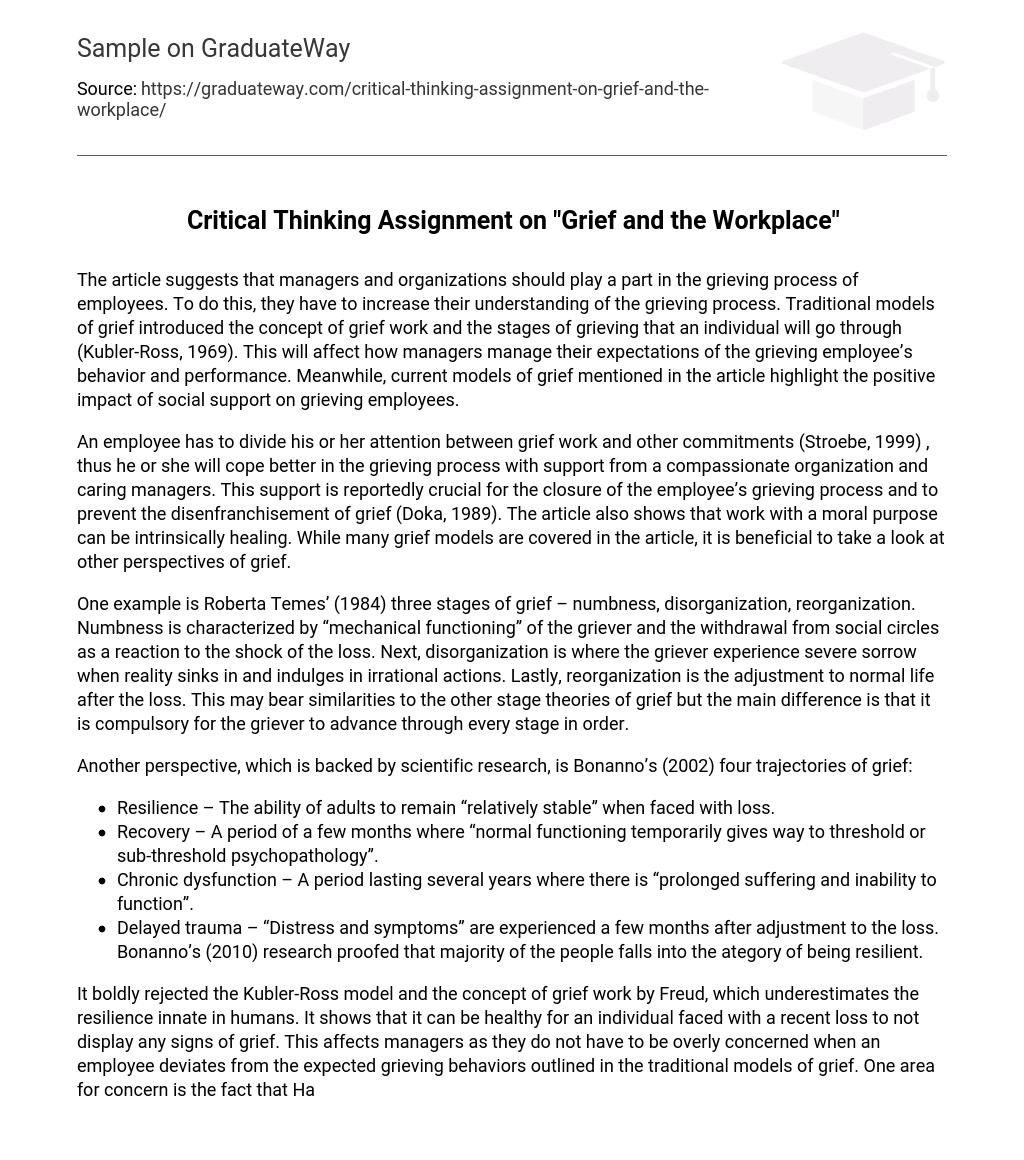The article suggests that managers and organizations should play a part in the grieving process of employees. To do this, they have to increase their understanding of the grieving process. Traditional models of grief introduced the concept of grief work and the stages of grieving that an individual will go through (Kubler-Ross, 1969). This will affect how managers manage their expectations of the grieving employee’s behavior and performance. Meanwhile, current models of grief mentioned in the article highlight the positive impact of social support on grieving employees.
An employee has to divide his or her attention between grief work and other commitments (Stroebe, 1999) , thus he or she will cope better in the grieving process with support from a compassionate organization and caring managers. This support is reportedly crucial for the closure of the employee’s grieving process and to prevent the disenfranchisement of grief (Doka, 1989). The article also shows that work with a moral purpose can be intrinsically healing. While many grief models are covered in the article, it is beneficial to take a look at other perspectives of grief.
One example is Roberta Temes’ (1984) three stages of grief – numbness, disorganization, reorganization. Numbness is characterized by “mechanical functioning” of the griever and the withdrawal from social circles as a reaction to the shock of the loss. Next, disorganization is where the griever experience severe sorrow when reality sinks in and indulges in irrational actions. Lastly, reorganization is the adjustment to normal life after the loss. This may bear similarities to the other stage theories of grief but the main difference is that it is compulsory for the griever to advance through every stage in order.
Another perspective, which is backed by scientific research, is Bonanno’s (2002) four trajectories of grief:
- Resilience – The ability of adults to remain “relatively stable” when faced with loss.
- Recovery – A period of a few months where “normal functioning temporarily gives way to threshold or sub-threshold psychopathology”.
- Chronic dysfunction – A period lasting several years where there is “prolonged suffering and inability to function”.
- Delayed trauma – “Distress and symptoms” are experienced a few months after adjustment to the loss. Bonanno’s (2010) research proofed that majority of the people falls into the ategory of being resilient.
It boldly rejected the Kubler-Ross model and the concept of grief work by Freud, which underestimates the resilience innate in humans. It shows that it can be healthy for an individual faced with a recent loss to not display any signs of grief. This affects managers as they do not have to be overly concerned when an employee deviates from the expected grieving behaviors outlined in the traditional models of grief. One area for concern is the fact that Hazen has included numerous studies and views of many reputable grief experts but failed to include the works of Bonanno which does not support her arguments.
The article may also be lacking in objectivity as Hazen has cited her own work no fewer than six times. This suggests that it may be possible for Hazen to be committing confirmation bias. In some of her cited studies, the sample sizes for the interviews conducted are too small. For example, the three interviews studying the perinatal loss of women; social workers after client suicide; and care-giving staff members, all had a sample size of smaller than thirty. This may not provide an accurate representation of the population. Also, some figures included in the article are questionable in terms of its legitimacy.
It was reported that “hidden grief costs U. S. companies up to $75. 1 billion annually”. However, it was not revealed in the article how the huge estimated figure was derived. One of the key assumptions in the article is that every individual faced with a loss will go through the same pattern of grief behavior prescribed by the traditional grief models. The lack of display of these behaviors is therefore presented as an area of concern for stifled or disenfranchised grief. This assumption has in fact been proven wrong by Bonanno’s work. He came up the term “coping ugly” to show that people have different ways of coping with loss (Stix, 2011).
It may be healthy for people to have no response or even counter-intuitive responses like laughter (Bonanno G. A. , 2004). Another assumption is that grieve counseling is beneficial for grieving employees. But numerous research on grieve counseling and therapy by Robert Neimeyer (Konigsberg, 2011) and Bonanno have shown it to be ineffective and even potentially harmful for most people. It has shown usefulness only for individuals with complicated grief. The article is mainly US-based and does not illustrate the differences in cultural impact and society’s expectations of a grieving person.
Americans and western cultures are in general more open to expressing their emotions as compared as the more conservative Asian cultures. Furthermore, resilience may be viewed as strength while display of emotions during work may be viewed a sign of weakness for some cultures. Lastly, recommendations provided in the article may be less helpful in light of the alternative perspectives being introduced. It was suggested that managers should have an expectation of how a grieving employee should behave based on the traditional models of grief.
However, it may encourage the unnecessary pathologization of grieve when concerned managers failed to observe those behaviors. Instead, managers should have a more open mindset of what constitutes healthy responses to avoid mistaking resilience as delayed grief. Although supportive and caring work organizations and managers are beneficial for grieving employees, grieve counseling should be recommended with care. Preferably, it should be recommended to employees with difficulty coping with the loss, and not those with normative responses.





